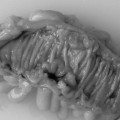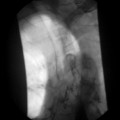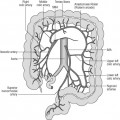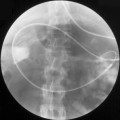CHAPTER 23 Radiotherapy and chemotherapy of GI tract malignancy
Introduction
There are several different parameters used to measure ‘benefit’ from chemotherapy or radiotherapy (Table 23.1). These terms are often used as endpoints in clinical trials assessing the efficacy of a treatment regimen.
Table 23.1 Definitions of outcome parameters used to measure efficacy of a treatment regimen
| Outcome parameter | Definition |
|---|---|
| Median survival1 | The time from either diagnosis or start of treatment at which half of the patients with a given disease are found to be, or expected to be, still alive |
| 5 year survival | Proportion of patients still alive 5 years after diagnosis or start of treatment |
| Cancer specific survival | Can be used as median survival or 5 year survival but includes patients who are still alive and those who died of causes not related to their cancer |
| Progression-free survival1 | The length of time from either diagnosis or start of treatment in which a patient is living with a disease that does not get worse |
| Time to progression1 | A measure of time after a disease is diagnosed (or treated) until the disease starts to get worse |
| Response rate1 | The percentage of patients whose cancer shrinks or disappears after treatment |
1 Definitions adapted from the National Cancer Institute, www.cancer.gov [accessed 4 June 2008]
Colorectal cancer (CRC)
Radiotherapy
The risk of local recurrence of rectal cancer following surgery correlates with the presence of microscopic tumor cells within 1 mm of the circumferential resection margin (CRM) (Quirke et al., 1986; Nagtegaal et al., 2002). External beam megavoltage radiotherapy can be administered to sterilize the surgical field and has therefore established a role in the treatment of rectal cancer as an adjunct to definitive surgery. There is no established role for adjuvant radiotherapy in the treatment of colon cancer.
The three adjuvant radiotherapy regimens in common practice are:
If a rectal cancer is considered operable at the outset, then a short course of radiotherapy may be given prior to surgery to reduce the risk of local recurrence. If a rectal cancer is considered to be inoperable or only potentially operable, then a long course of rectal radiotherapy, with or without chemotherapy, is given to downsize the tumor and increase the chance of a clear resection margin.
The ‘operability’ of a rectal cancer is determined by a pelvic magnetic resonance imaging (MRI) scan. A large European multicenter prospective study (MERCURY study) has demonstrated that MRI scans can accurately measure the depth of extramural tumor spread to within 0.5 mm (MERCURY, 2007). It is essential that each patient has a pelvic MRI scan which is discussed at a multidisciplinary meeting prior to commencing treatment to determine the optimal sequencing of the multimodality treatment. Patients are selected for long course preoperative radiotherapy (with or without chemotherapy) if there is felt to be a high chance that the surgeon will not be able to perform a curative (R0) resection based on the following findings on the pelvic MRI scan:
Short course preoperative radiotherapy
The Northwest Cancer Group published a randomized study evaluating a short course of preoperative radiotherapy for patients with tethered or fixed tumors (Marsh et al., 1994). A recurrence rate of 36.5% with surgery alone was significantly reduced to 12.8% by the addition of 20 Gy in 4 fractions (P = 0.0001). A survival advantage was demonstrated in the radiotherapy arm for patients that had a curative resection (53.3% versus 44.9% at 8 years, P = 0.033).
The well-quoted ‘Swedish’ study randomized 1168 patients planned for surgery to a short course preoperative radiotherapy regimen of 25 Gy in 5 fractions or surgery alone (Anonymous, 1997). An improvement in local recurrence rate (11% versus 27%; P < 0.001) and a 10% absolute improvement in 5-year survival (48% versus 58%; P = 0.004) was demonstrated.
The practice of total mesorectal excision (TME) has also led to improved local recurrence rates. The ‘Dutch’ study compared the benefits of TME with or without preoperative radiotherapy (Kapiteijn et al., 2001). A total of 1861 operable patients were randomized to receive preoperative radiotherapy (25 Gy in 5 fractions) followed by TME or TME alone. The local recurrence at 2 years was significantly lower in the radiotherapy arm (2.8% versus 8.2%; P < 0.001) but overall survival was the same (82% for both groups).
The MRC CR07 trial randomly assigned 1350 patients with operable rectal cancer stage I to III to preoperative short-course radiotherapy (25 Gy in 5 fractions over 1 week) or surgery alone (Sebag-Montefiore et al., 2006). Patients in the surgery alone arm underwent postoperative chemoradiotherapy (45 Gy in 25 fractions with concomitant infusional 5-fluorouracil (5-FU)) if the resected specimen had positive circumferential margins. Compared to selective postoperative radiotherapy, preoperative radiotherapy reduced local recurrence from 11% to 5%. As expected, local recurrence rates were lower in the 596 patients who underwent optimal surgery with a total mesorectal excision (TME). In this group, local recurrence reduced from 6% with selective postoperative radiotherapy to 1% with preoperative radiotherapy. There was no difference in overall survival.
The benefits in local control demonstrated by these studies must be balanced against long-term toxicity from this hypofractionated regimen in the large numbers of patients with operable, good prognosis rectal cancer. Both the Dutch and Swedish studies have demonstrated increased incidence of bowel dysfunction in the irradiated group compared with surgery alone (Peeters et al., 2005; Birgisson et al., 2005). The Swedish group have also shown an increased incidence of second malignancies in the irradiated group (Birgisson et al., 2005). The early Northwest Cancer Group study demonstrated the benefit of using a lower dose regimen of 20 Gy in 4 fractions preoperatively (Marsh et al., 1994). A more recent retrospective audit from the Northwest group has suggested that delivering the lower dose regimen preoperatively to a smaller treatment volume than adopted in the Swedish and Dutch trials provides comparable local recurrence rates in patients with operable rectal cancer (Saunders et al., 2006).
Long-course radiotherapy
The MRC CR02 trial showed a 10% reduction in local recurrence when surgery was preceded by radiotherapy (40 Gy in 20 fractions) in potentially operable rectal cancers (5 year local recurrence 36% versus 46%, P = 0.04) (MRCRCWP, 1996). A more recent Cochrane meta-analysis assessing the role of preoperative radiotherapy in rectal cancer confirmed an improvement in local control with greater benefits in patients treated with a biologically equivalent dose (BED) of >30 Gy (Wong et al., 2007). The addition of chemotherapy to long-course radiotherapy has been shown to improve locoregional control. This was first demonstrated in the NSABP-02 trial randomizing patients with Dukes B or Dukes C rectal cancer to postoperative chemotherapy alone or concomitant long course postoperative CRT (Wolmark et al., 2000). A reduction in locoregional relapse from 13% in the chemotherapy arm to 8% in the CRT arm led to postoperative CRT becoming the standard adjuvant treatment of rectal cancer in North America (NIH, 1990). The EORTC 22921 trial randomly assigned patients with clinical stage T3 or T4 resectable rectal cancer to receive one of four regimens:
Radiotherapy consisted of 45 Gy in 5 weeks. Two courses of chemotherapy (5-FU 350 mg/m2 per day and leucovorin 20 mg/m2 per day for 5 days) were combined with preoperative radiotherapy and four courses were used for adjuvant postoperative chemotherapy. With a median follow-up of 5.4 years, overall survival was comparable in all four groups. The 5-year cumulative incidence rates for local recurrences were 8.7%, 9.6% and 7.6% in the groups that received chemotherapy preoperatively, postoperatively, or both, respectively, and 17.1% in the group that did not receive chemotherapy (P = 0.002) (Bosset et al., 2006).
The German Rectal Cancer Study Group directly compared preoperative long-course chemoradiotherapy to postoperative chemoradiotherapy. Preoperative chemoradiotherapy resulted in reduced 5-year local recurrence (6% versus 13%, P = 0.006) and fewer grade 3 or 4 acute toxicities (27% versus 40%, P = 0.001) and late toxicities (14% versus 24%, P = 0.01) compared to postoperative chemoradiotherapy (Sauer et al., 2004).
Chemotherapy
Meta-analyses have shown that chemotherapy for advanced CRC can slow progression and prolong disease survival compared with best supportive care (Simmonds, 2000, Anonymous, 2000). For nearly 50 years, 5-fluorouracil (5-FU) has been the mainstay of chemotherapy treatment for CRC and fluoropyrimidine-based chemotherapy remains a key component of the treatment algorithm for advanced disease. Indeed, until 10 years ago, 5-FU was the only chemotherapy option available to patients. 5-FU administered as a continuous infusion has superior efficacy when compared with 5-FU administered as an intravenous (IV) bolus (RR 22% versus 14%) (Anonymous, 1998a) and is associated with fewer World Health Organization grade 3 and 4 toxicities (Anonymous, 1998b).
Oral fluoropyrimidines, such as capecitabine and tegafur/uracil (UFT) are converted to 5-FU through various enzymatic conversions. Randomized trials (Hoff et al., 2001; Douillard et al., 2002; Carmichael et al., 2002; Van Cutsem et al., 2004a) have shown equivalence to bolus 5-FU/folinic acid (FA) but have not compared oral fluoropyrimidines to infusional 5-FU. Oral fluoropyrimidines now offer the patient a more convenient form of chemotherapy compared to single-agent infusional or bolus 5-FU.
The addition of irinotecan to 5-FU/FA, irrespective of regimen, conferred a significant clinical benefit, in terms of response rate (RR), progression-free survival (PFS) and overall survival (14.8 versus 12.6, 20.1 versus 16.9, 17.4 versus 14.1 months) compared with the corresponding 5-FU/FA regimen alone (respectively for Saltz et al., 2000; Douillard et al., 2000; Kohne et al., 2005), although it was associated with a higher incidence of grade 3 diarrhea.
Oxaliplatin is also effective first-line in the treatment of advanced CRC when combined with 5-FU (Giacchetti et al., 2000; de Gramont et al., 2007). RRs and median PFS times were longer in the oxaliplatin/5-FU/FA arms compared to the 5-FU/FA alone arms. However, median overall survival was not increased in the oxaliplatin arms. This may be attributable to cross-over from the 5-FU/FA to the oxaliplatin/5-FU/FA arms. The principal dose-limiting toxicities are neurotoxicity (which may be acute or chronic) and neutropenia (Grothey and Goldberg, 2004).
The relative efficacy of these two regimens was directly compared in the randomized Tournigand trial (Tournigand et al., 2004). Patients were randomized to one of two treatment arms. Those in arm A received FOLFIRI (irinotecan 180 mg/m2 and FA 200 mg/m2 on day 1, followed by bolus 5-FU 400 mg/m2 and continuous 5-FU, 2400–3000 mg/m2, by 46-hour infusion) until disease progression or unacceptable toxicity, at which time they crossed over to receive oxaliplatin (100 mg/m2 on day 1) in combination with the same modified de Gramont 5-FU/FA regimen (FOLFOX6). Conversely, the patients assigned to arm B received FOLFOX6 until disease progression, at which time they crossed over to receive FOLFIRI. The median overall survival was 21.5 months in arm A (FOLFIRI followed by FOLFOX6) and 20.6 months for patients assigned to arm B (FOLFOX6 followed by FOLFIRI), leading to the conclusion that the two regimens were essentially indistinguishable in terms of efficacy. However, it was noted that a significantly higher number of patients in arm B had their metastatic disease rendered resectable (P = 0.02). The most important observation from the Tournigand study was therefore that median survival was in excess of 20 months for both arms when the two combinations were used sequentially (i.e. the use of three active drugs during the course of the patient’s treatment).
The UK MRC CR08 FOCUS trial was designed to assess the role of irinotecan or oxaliplatin combined with the modified de Gramont (MdG) infusional 5-FU/FA regimen, in the first- and second-line treatment of patients with advanced CRC. Patients with good performance status were randomly allocated to receive either single agent chemotherapy first line followed by combination chemotherapy at failure or combination chemotherapy upfront. Non-significant increases in overall survival were seen with each combination therapy over the staged single-agent arm (Seymour, 2005). This suggests that staged combination therapy may provide an alternative treatment strategy for those patients unable to tolerate first-line combinations. The optimum duration of treatment was assessed in the CR06 study (Maughan et al., 2003). After 12 weeks (6 cycles) of chemotherapy, patients with evidence of response or stable disease were randomized to stopping treatment, restarting with the same regimen on progression or continuing chemotherapy until progression. The study showed no benefit in continuing chemotherapy indefinitely and patients in the intermittent group had significantly fewer toxicities and adverse events.
Targeted agents
As our knowledge of tumor biology and genetics matures, a range of agents that interact with novel disease-associated targets are emerging into the clinical setting. Two drugs already approved for the treatment of CRC are the monoclonal antibodies cetuximab (Erbitux®), which binds to and inhibits activation of the epidermal growth factor receptor (EGFR) (Li et al., 2005), and bevacizumab (Avastin®), which binds vascular endothelial growth factor (VEGF-A) thereby interfering with signaling through the VEGF-1 and -2 receptors and inhibiting angiogenesis (Hicklin and Ellis, 2005).
Cetuximab has been approved in both Europe and the USA for use in combination with irinotecan, as second-line therapy in CRC patients who have failed prior irinotecan treatment. In the pivotal study, Cunningham and colleagues (Cunningham et al., 2004
Stay updated, free articles. Join our Telegram channel

Full access? Get Clinical Tree












